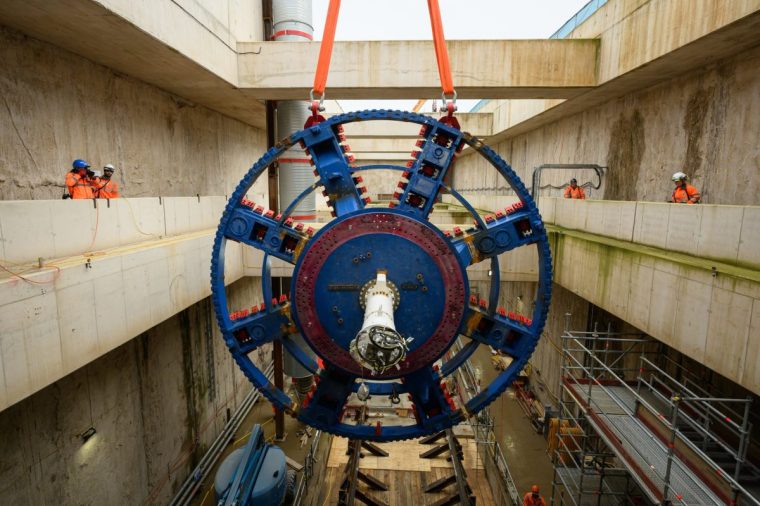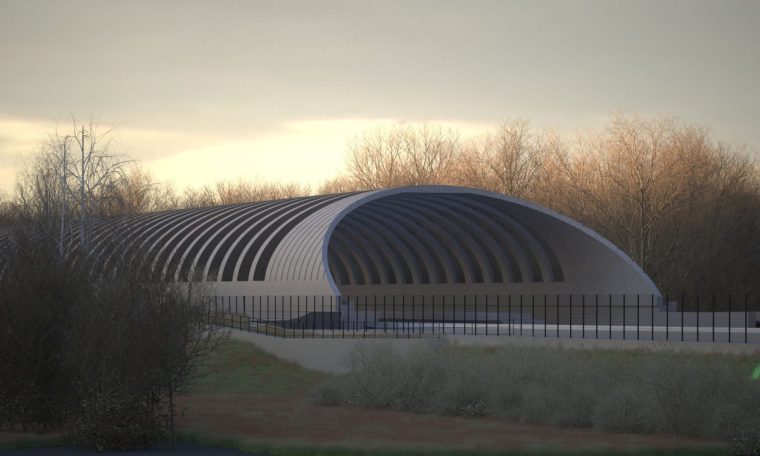Standing at the bottom of a man-made cliff face of reinforced concrete, 20m below ground, you can see the first cuts of a 4.5 mile tunnel that will run through thick London clay towards Euston.
After nearly 18 months of dithering and delay, HS2 has finally been given the green light to start tunnelling from Old Oak Common in West London to the originally intended terminus in the centre of the capital.
The move, announced by Chancellor Rachel Reeves in her autumn Budget, puts to bed the uncertainty that has surrounded the high-speed line ever since former prime minister Rishi Sunak announced in 2023 that the rail scheme would not run beyond Birmingham to Manchester and the plan to terminate it in Euston was on hold.
“There’s no doubt that 2025 is the year that HS2 gets back on track,” Huw Edwards, stations delivery director at HS2 Ltd, told The i Paper from the mouth of one of the yawning tunnels.

While the arm’s length delivery body has yet to be told the full size and shape of the budget it will receive to dig the tunnels to Euston, it is expected that work will begin in 2025 with a completion date set for 18 months later.
Political hand-wringing
There is frustration within the industry that crucial time was lost due to the political handwringing over the cost of the high-speed railway, with delay itself further pushing up the cost due to inflation.
But above all there is a sense of disappointment that the loss of cross-party consensus has damaged the overarching aim of delivering what is the biggest infrastructure in western Europe and the benefits that the railway line will bring in terms of economic growth.
Asked about the effects of the past 18 months of political mudslinging and negative headlines around HS2, Edwards said: “It has brought its challenges. We thought there was cross party support across those 10, 12, 14, years but that didn’t seem to be that case.
He added that the aim now is to try and ram home the tangible benefits that delivering such a major piece of infrastructure will bring to people.
“I have worked on nine major rail projects over 34 years – be it Docklands Light Railway, the Jubilee line, HS1, Crossrail – and they all have this moment where people can’t actually see what we can see,” he said.
‘Fantastic, incredible infrastructure’
“We arrive on site on day one, and put up an eight foot high hoarding up around us. From that point forwards people can’t see in. It’s only when we get to the latter stages that people understand the fantastic, incredible infrastructure, the incredible preparation that’s gone in. So, we see 2025 as a reset year. What we want to drive home is that capital expenditure is the thing that’s focused on, but benefits is the thing that’s forgotten about.”

Edwards highlighted a recent report produced by Camden Council that calculated the benefit of HS2 arriving into Euston would provide £41bn in benefits to the local economy.
The link between delivering major infrastructure to help fuel growth is well established, but there have long been doubts within certain quarters of the construction industry that the Treasury accurately captures the full value to the economy of infrastructure schemes under its cost/benefit ratio calculations.
Edwards highlighted the challenges around forecasting the economic benefit of any rail scheme, but suggested that more needed to be done to get the message across to the public of the need for such projects.
“Are the public aware of the massive benefits until the end of date? The answer is certainly not,” he said. “They will read a set of headlines but that only gives a small shaft of light on what is occurring. I spent nine years creating the London Overground network – we were hitting our five year projections within 12 months. None of the business cases were foreseeing that.”
A failure to run HS2 to Euston would have made the business case for the rail scheme almost non-existent, especially after the previous Tory government’s decision to sever the train line at Handsacre just north of Birmingham, citing cost and value for money concerns.
225mph trains on creaking tracks
As one senior rail exec told The i Paper the decision will amount to the rail network having to “run Ferraris on dirt roads” as the 225mph HS2 trains will be forced onto the creaking West Coast Mainline tracks.
While there is no prospect of the high speed line north of Birmingham being resurrected, in the short term at least, the primary aim of the Government is to ensure the remaining HS2 plans are on a stable footing after years of turmoil.
After an initial cost estimate of £37.5bn in 2009, the forecast spend on the scheme has ballooned to an estimated £66.5bn – or £475m per mile of track.

The arm’s-length body HS2 Ltd has come under fire over its handling of the scheme and has faced accusations of allowing costs to spiral, although insiders would point to the regular changing in scope by politicians as being behind at least part of the increases.
Former transport secretary Louise Haigh launched a Government review into the body with an interim report due out in the coming weeks, but ministers are hopeful that the arrival of Mark Wild, who was instrumental in getting Crossrail back on track, as the chair of HS2 Ltd will lead to major improvements.
Rail minister Lord Hendy, who was chair of Network Rail for nearly 10 years, told The i Paper: “Mark is the guy who sorted out Crossrail – he turned it into an operating railway and got it open. He’ll do the same here.
“He’ll take some time to find out what is going on, he’ll take some time to work out how long it will take to fix it and how much it will cost. When he says that, I believe him.”
The go-ahead to build the two 4.5 mile tunnels from Old Oak Common to Euston has been widely welcomed. But the scheme is fiendishly complicated in itself as the site is hemmed in by both the Elizabeth Line and the Great Western Rail line, the latter of which will have to be physically shifted 100m to one side to allow for the new HS2 station to be built.
Uncertainty about Euston
But there remains significant uncertainty about the construction of the HS2 Euston terminus, which, as it stands, will be heavily dependent on private sector investment if it is to be built.
Sunak attempted to attract the private sector into stumping up the money for the scheme, offering the prospect of building 10,000 homes and businesses as a potential sweetener, but with little takers.
There remain serious doubts as to whether the 60-acre site could bring in the level of investment that is needed to build a new Euston station that will have to serve HS2 trains, the West Coast Mainline and the London Underground.
Unlike the nearby hugely successful King’s Cross redevelopment, Euston does not have the available land surrounding it to build housing at scale, while planning restraints – including long-standing sight lines of St Paul’s Cathedral from Primrose Hill – mean building higher density tower blocks on the station footprint is not feasible.
A failure to attract private investment raises the prospect of the Treasury having to foot the bill for the construction of the Euston revamp.
But Lord Hendy, who previously chaired the Euston Partnership overseeing the site, said the priority was to get Treasury funding to build the tunnels to central London.
“The next job is to sort out how we fix Euston – how we build a station that is fit for HS2, fit for the national railway network. We’re on the case, but you will have to give us some time,” he said. “When we took office it wasn’t clear that Euston would have been served at all, it would have stopped here [at Old Oak Common] and that wouldn’t have been much good at all.”

